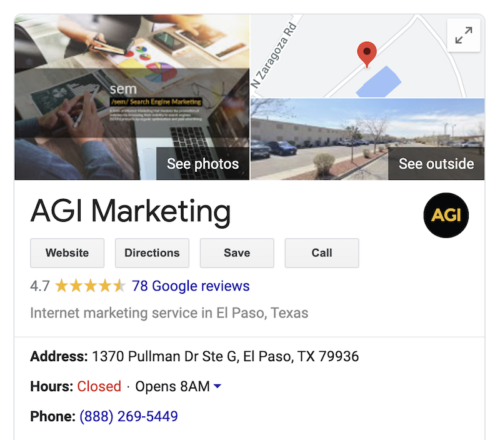When it comes to creating an effective, cohesive Google Ads promotion strategy for your local business, you need to get intimately acquainted with two words: customer intent. Understanding why customers are looking for your product or service will help you tailor your ads for optimal conversion.
About 70 percent of consumers use their smartphones for research about related ideas or items long before they press the Buy button. As a local business, you have a long-term opportunity to guide those consumers to your brand, instead of just rushing them to take immediate action.
The Role of Content Marketing
Gone are the days when businesses simply send traffic to their product pages and wait for the sales avalanche. That’s akin to throwing spaghetti against a wall, and you have too much competition to take that chance. You need to purposefully create content around your product or service that not only highlights what you offer but speaks about the solutions it provides. Whether it’s a blog, video, or case study, content is the foundation of your Google advertising efforts.
Before Google Ads, There’s the Buyer’s Journey
To get a better handle on customer intent, you need to be acquainted with the buyer’s journey, which consists of three states a buyer is in prior to purchase.
- Awareness: Your potential customer knows something’s wrong and is trying to figure out the exact problem. At this point, you consider them warm and more open to your offering. This is a great time to implement brand awareness campaigns that start with understanding what terms this customer is likely to use. A simple brand awareness campaign is not a hard pitch to convert the viewers into buyers. It’s about putting your brand in their heads, so that when they’re ready, they’ll remember you.
- Consideration: At this point, they’ve isolated the exact cause of their pain and are actively researching solutions. They’re warmer at this stage and are looking at different products to help. Here, your promoted content needs to contain information about different solution options. You may even compare and contrast your solution to that of your competitors.
- Decision: The consumer found the exact solution and is comparing the solutions your business provides but not necessarily from your business. This is the hot stage, where they are ready to buy. The best way to guide them to your brand is to present them with highly targeted content that addresses their specific problem and how you are the best choice to help them solve it.
Effective Use of PPC Advertising
Pay-per-click, PPC, advertising is one of the most common ways to use Google Ads. With the key terms you came up with at each leg of the buyer’s journey, along with your content, you can use PPC ads to drive specific types of viewers to those pieces of content. There are a few ways to make your ads even more effective.
Grouping single keywords helps you to target specific audiences, improving click-through rates and quality scores. With the level of granularity grouping provides, it’s easier for you to tweak ad copy and make it more relevant to your audiences.
Ad extensions are another technique you can implement to boost conversion rates. If you have multiple store locations within a city, you can list them as location extensions on the same ad. Visitors will see specific information related to the store near them.
Call extensions provide a call button on the ad, giving visitors the opportunity to interact with your brand while giving you the chance to personally compel them to choose your product or service.
Finally, dynamic site links show visitors content based on their intent. This is one of the key reasons why local businesses need to create content around the different states of the buyer’s journey. Optimized content increases the time users will spend on your site and improves sales potential.
Improve Repeat Sales with Remarketing
Studies show that 98 percent of visitors leave and may never return. The reasons vary, but with remarketing you have the opportunity to coax them into returning to your site, increasing the chances of a purchase.
Remarketing not only increases brand awareness but when used on existing customers, sell rates are 60 to 70 percent compared to between 5 and 20 percent for new customers. Retaining customers is important to local businesses because it’s far cheaper than attracting new ones. To make remarketing ads more effective, segment your list to create more personalization. With tailored landing pages and calls-to-action, it’s easy for you to speak to specific customers’ needs.
Tips for Using Google’s Display Ads
Google Display Network, GDN, has over two million partner sites it uses for advertising. A multitude of criteria, including content and advertising budget, dictate where your display ads are shown. These are one of the most challenging types of online advertising, but if they are done well and correctly, they can keep you on the tip of the customer’s tongue. Advertisers only have one or two seconds to get the customer’s attention, so your ads need to be visually striking with a clear message.
You can’t really target display ads as precisely as text ads, and the key performance indicators, KPIs, are more about impressions served than clicks. This is why it’s extremely important that when consumers see your promotion, it immediately makes an impact. One marketing rule to remember with display ads is that customers will need to see it at least seven times, maybe as many as 10 times, on average before they do business with you.
What makes a display ads successful depends on several factors, but there are a few ways to improve your ad’s visibility and effectiveness:
- Communicate the value of what you offer immediately by communicating key features or benefits of your product or service, rather than the benefits. This means you’re better able to.
- Because real estate is limited, you’ll need to have a powerful hook that communicates everything in one or two seconds, which is about five to eight words.
- Remember to include your logo and business name in the ad to reinforce brand awareness
- Choose the types of display ads you want and create them to spec. You can create both static and HTML5 ads.
- Make sure your call-to-action visually contrasts with the other text in the ad, so that it’s easily recognized.
Finally, consider strategically using emojis in your ads. Because they have become a part of the linguistic landscape, they are easily recognizable. If you’re clever enough, customers will get the message much faster and may act sooner.
Set Your Business Apart with Local Service Ads, LSAs
Local service ads, LSAs are similar to PPC ads. The main difference is that while PPC ads charge per click, LSAs charge per lead for calls that are 2 minutes and over. These ads are all about proximity to the consumer as well as positive reviews associated with your business. To start, there are a few verification steps to get a local service ad running.
- Google Guaranteed is for businesses that provide residential services, such as plumbers and electricians. It requires background licensing and insurance verification, and customers’ claims are covered for up to $2,000.
- Google Screened is a verification service that is mostly for lawyers and financial service providers. To get that green checkmark beneath their name, businesses need to have a minimum customer review rating of 3 stars.
Because LSAs are more geared towards providing business owners with leads, advertising costs just a fraction of what they would pay for PPC ads. Additionally, small businesses don’t have to do regular ad campaigns to get access to local search ads. This can be a game-changer for those who don’t necessarily have the budget or know-how for regular PPC or display advertising and rely heavily on word-of-mouth to get customers.
Consider Combining Your Google My Business Listing with Google Ads
Google My Business, GMB, is a free business listing service where customers who are searching for a particular company can see photos, reviews, and get directions to that location. When setting up your Google My Business listing, it’s important to optimize it properly. This means adding relevant categories to your listing and ensuring that your business title, description, and other associated data contain the terms you want to rank for.
When you link your GMB to Google Ads, location extensions will automatically show up on your PPC ads. If you have a business with multiple locations, you can filter which locations to advertise in the extensions. Filtering is usually done by name, but if you choose to do it by label, make sure that the label is added to the GMB listing beforehand. You can add a filter to different levels within your Google Ads account.
Your listing on Google My Business provides credibility and authority, instilling a sense of trust in your potential customers and making it easier to turn them into leads. Combined with other forms of online advertising, small businesses can ensure that they are doing all that’s necessary to reach local customers at every point in their buyers’ journeys.
Get the Most with Search Engine Optimization!
Another key piece of securing local advertising success is SEO. A well-maintained and optimized site reduces online advertising costs, helping companies to reach more local customers. AGI Marketing is all about providing creative solutions for local businesses. We specialize in creating opportunities that increase leads and foot traffic. Contact us and get a free SEO audit for your website today.










